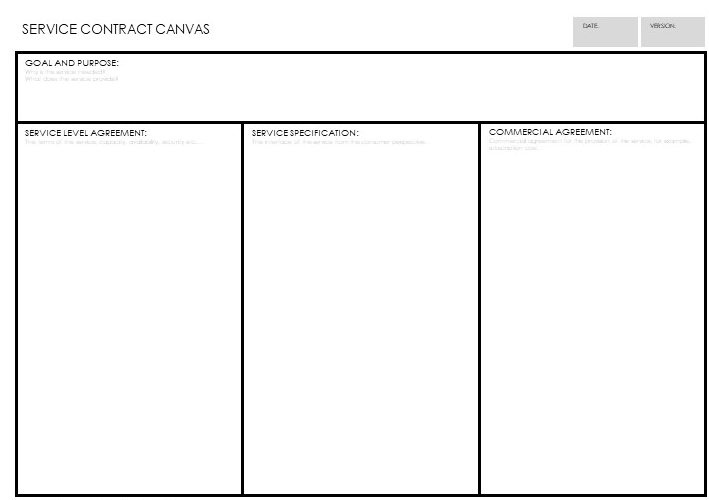
In the IT sector the term “service” is widely used in a number of contexts. In the context of this article, services are a way of realising a of realizing a capability. This is to say that a capability will deliver value though providing services.
The Open Group provides a description of the characteristics of service as follows:
- It is a logical representation of a repeatable business activity that has a specified outcome
- It is self-contained
- It may be composed of other services
- It is a “black box” to consumers of the service
(this means that the consumer of the service does not have to know about the inner workings of the service)
The services which are provided by a capability may be manual, automated or more often a mix of both. Just as a capability is composed of people, processes and technology, a service may also be composed of people who provide the service, process which describes the workings of the service and technology which automates the service.
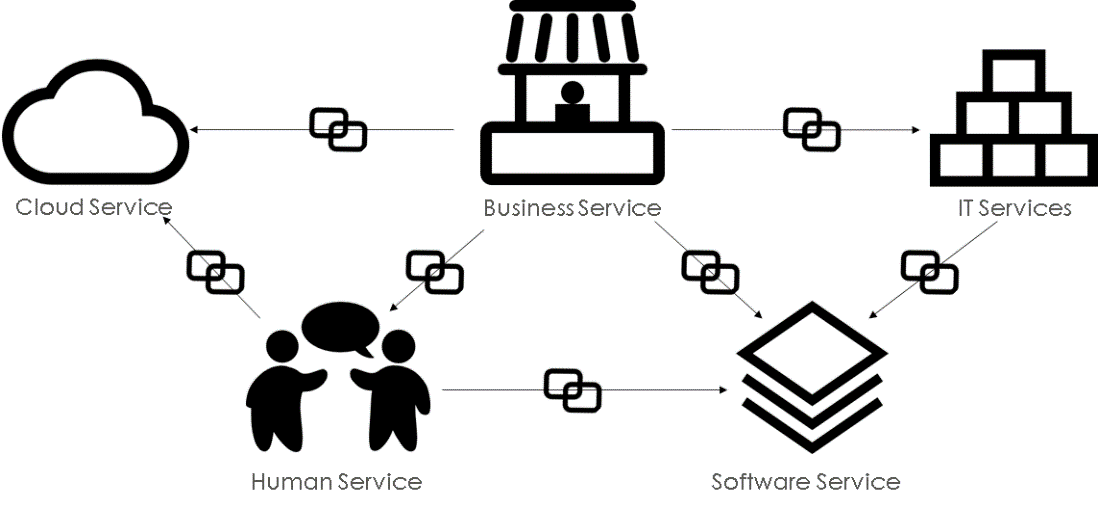
In this article services are considered in two contexts:
- business service – services which provide business value from the capability to the consumer
- technical services – automated services using technology to provide value to the consumer
Why we need Services
Services provide a flexible and adaptable way to build business and a technical architecture. The nature of service-orientation is a focus on the consumption of the service and the outcome. This aligns well with business where we are interested in what the service provides rather than how the service achieves the result. This is why services are a “black box” to the consumer, the consumer only needs to worry about what is provided to the service and the outcome of the service.
Another advantage of services is that they are self-contained. This allows the inner workings of the service to change without changing the surrounding consumers of the service. The scope of change is reduced, so optimizing implementations, changing technologies or even whole systems has a lesser impact on the surrounding IT landscape.
Services promote re-use. If services already exist, they can be incorporated in other services. This means that new services can quickly be created by composing a series of existing services (this may be referred to as Service Orchestration). This provides a fast way to create value from resources which already exist.
Service Approach
SOA (Service-Oriented Archtiecture) is an architecture style which facilitates the provisioning of services, often with focus on technical services but the key principles can be applied to all types of services. SOA architectures are widely used in industry and there are many articles and books written on the subject, and therefore this article does not cover SOA architectures in detail but instead focuses on services. The following are some of the key factors in successfully developing services and a SOA architecture.
Service contract is key
The service contract is the link between the consumer and the provider of the service. This forms the agreement and expectations of the service. Getting the service contract right and maintaining it is key to ensure that the consumers of the service are satisfied.
Hide the inner workings
Services do not expose the inner workings of the service to the consumer. This is reduces complexity in consuming the service but more importantly provides the benefit of being able to change how a service works without having to change how the service is consumed. This make maintenance of the service easier and is a key factor in facilitating a quick reaction to business changes.
Services are published
In order to gain significant effect from a service architecture the potential consumers of the service need to be able to find the services and understand how to use them. This places a requirement on providing good documentation or descriptions on how to interact with the service, and ensuring that services are publish and promoted to potential consumers.
Design for re-use
When designing services consider that the service should be re-useable by a number of consumers. Creating services which have a highly specialized contract reduces re-usability and increases dependency. Enabling re-use of services brings significant business benefits and make maintenance of services easier.
Services play together
When developing services, it is important to consider how services work together. A business service may be composed of a number of technical services, and a technical service may also be composed of some other technical services. Re-use and decomposition of services is a strong factor in building an architecture as it provides a way to break complex activities into a number of less complex activities, with the added option of re-using any existing activities.
Keep services stateless
Keeping services stateless promotes scalability in the architecture. If the service itself maintains a state that state has to be managed if we scale the service to a number of instances. In other words, the service has to be aware of its consumers. Keeping the service stateless allows the service to be scaled, meaning that any number of consumers can use any instance of the service and still achieve the expected result from the service. This avoids complex problems in the infrastructure as demands on capacity, availability and performance grow.
Avoid Fragmentation
Services are a good way be break up a large business activity into a number of smaller activities and provide flexibility in the architecture. However, the granularity of services comes with an overhead. As the number of services increase the effort for managing the services also increases. This may include, for example, managing versions, deployments, installation, operations and monitoring. If the cost for managing the services outweighs the benefits of flexibility it may be more advantageous to consolidate services and avoid fragmentation.
Delivering Services
Services have a strong relationship with the capabilities. While the capabilities describe what a business does or needs to do, the service provides a way of realizing capabilities and delivering them to consumers.

In the diagram above example capabilities are shown for customer support at various levels. In order to deliver the “Resolve Customer Enquiry” capabilities the provider needs to implement how to deliver the capabilities using people, technology and processes. This is packaged into a service which provides these capabilities to the consumer. The provider of the service performs the work required to deliver the service using people, technology and processes. In order for a consumer to use the service, the consumer and provider have to agree on the terms of the service, this is done though a service contract.
In the case above the Customer Enquiry Service will provide consumers with a contract for:
- Responding to and tracking request
- Managing complaints
- Self-help
This is valid for both business services and technical services, however when providing technical services, the provider will heavily depend on technology to automate service delivery. An important factor in the provision of services is that the consumer only needs to know about the contract for the service, the consumer does not need to know about the inner workings of the service as implemented by the provider.
The Service Contract
The Service Contract is central to the delivery of services and provides an agreement between the consumer and the provider of a service. This is a particularly important aspect of a service as it provides a description of how the service can be used and what can be expected from the service. A Service Contract applies to business services and technical services, although the description of the contract may be very different.
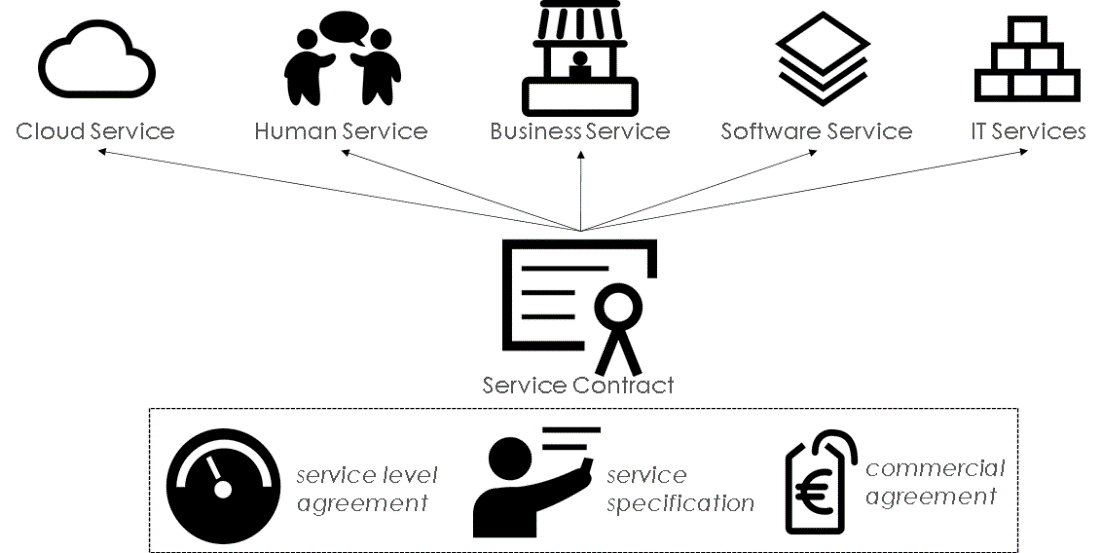
The following three areas describe a Service Contract for both business and technical services:
Service Level Agreement – defines the Quality of Service (QoS) that can be expected of the Service
- should state obligations on both Service Provider and Service Consumer in terms of the performance, availability and security provided by the Service.
- for a Business Service it may extend to warranty and support terms
Service Specification – describes how the service can be used
- identifies the Capabilities provided by the Service
- defines the behavior of the Service as seen through the use of its Interface
- used by the Service Consumer to discover Services that provide the required Capabilities
- understand how Service Interfaces can be used.
Commercial Agreement – defines the commercial terms for using the Service
- cost of use
- period/term of use
- penalty clauses
The context of the service may determine how complex the Service Contract is. For example, a service which is only used within a single solution may be covered by the commercial agreement or service level agreement for the solution. However, a service which is used specifically by external parties may have a Service Level Agreement and Commercial Agreement per customer.
Before considering the detail design or blueprint of a service the contract of the service can be defined. This provides the consumer view of the service. The following canvas can be useful in defining contracts for services. The following method can be used:
Step 1: State the goal and purpose of the service
It is important to state the goal and purpose of the service as this will provide a statement of the business activity and the expected outcome of the service.
Step 2: Service Specification
List the capabilities which are provided through the service. These can also be seen as the interaction between the consumer and the service. For each interaction with the consumer, consider what is required from the consumer to perform the interaction and what is the result of that interaction. For example, the service may provide a “Register Customer” capability, where “Customer Details” are required from the consumer, and the result of the interaction is that the consumer receives a “Customer Membership Number”.
Step 2: Service Level Agreement
Consider the service level which will be agreed between the consumer and provider. While the service specification addresses the capabilities of the service (or functional aspect of the service), the service level agreement often addresses non-functional requirements placed on the service. Examples of service level agreement attributes are, capacity in terms of numbers of users, number of transactions per day, level of security, availability or access to support. The service level agreement normally has a direct relation to the commercial agreement since a higher level of service drives costs.
It is also important to consider that the same service specification may be delivered under different service level agreements. For example, the same service capabilities may be provided to consumers under a “Silver” service level agreement with a support response of 24hrs, however “Gold” service level agreement may provide support response within 1h.
Step 3: Commercial Agreement
The commercial agreement addresses the terms of use for the consumer. Consider the business model for the use of the service. The consumer may pay a fee or a subscription to gain access to the service for a given time period, or a fee per transaction.
The commercial agreement should also include items which are constraints on the consumer use of the service. For example, restrictions on reuse of data or information provided by the service.
The Service Blueprint
While the service contract focuses on what the service provides to the consumer, the service blueprint describes how the service works and the way in which the consumer and provider work with the service. The service blueprint provides a way to design or analyze services.
The service blueprint is often applied to a specific scenario since a service can be used in a number of different ways to achieve the same outcome. The service blueprint considers the following aspects:
- Online/Physical Evidence (or Resources) – items or resources which are required in order for the provider and consumer to interact
- Consumer Actions – action the consumer performs to interact with the service, these may be partly defined in the service specification (Service Contract)
- Provider Frontstage Actions – actions the provider performs as part of the service to interact with the consumer, these may be partly defined in the service specification (Service Contract)
- Provider Backstage Actions – actions which the provider performs in order to deliver the service, these are the inner workings of the service
- Supporting Processes and Systems – other processes, systems or services which are required in order for the provider to perform a frontstage or backstage action
The service blueprint is used to describe how the service works with respect to time. It also identifies important resources and dependencies. The service blueprint can be used with both business services and technical services.
The following service blueprint canvas can be used with teams in a workshop or individually to help with the design and analysis of services. The following method can be used:
Step 1: Detail the Service and Scenario
Fill in the service name and the scenario which the blueprint will describe. It recommended to start with the simple commonplace scenarios before tackling more complex or special case scenarios.
Detail the expected outcome the service will provide from the scenario.
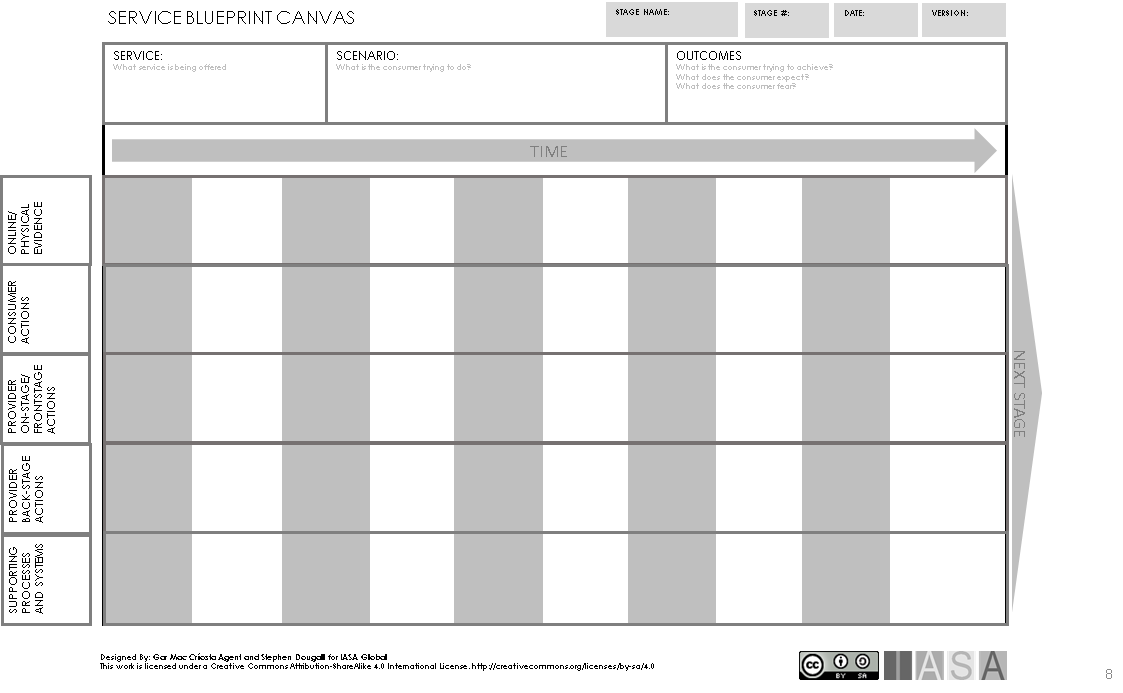
Step 2: Consumer and Provider Frontstage actions
The service blueprint is divided into time slots (columns). Starting with the first time slot start to detail the consumer actions and the provider frontstage actions in each time slot that describe the given scenario. This will detail the interaction between the consumer and the service. For example, the consumer may “Register Details”, and the provider may “Register Arrival” of the consumer.
Step 3: Online/Physical Evidence (resources)
From the consumer and provide frontstage actions consider which items or resources must be available to the consumer and provider in order to interact with the service. For example, in order for the consumer to register details a “Front Desk” with personnel must be in place.
Step 4: Provider Backstage Actions and Supporting Processes/Systems
Detail the inner working of the service for each time slot considering which activities are performed by the provider. For example, “Prepare Documents”, “Inform Personnel of Arrival”. These are activities that the provider is aware of but not the consumer. While detailing these activities consider if there are any dependencies to other processes/systems/services. For example, in order to prepare documents, there may be a dependency to the “Document Management Service”.
On completion, the Service Blueprint provides a detailed description of how a service works in a particular scenario, as well as the resources and dependencies required in order for the service to be delivered successfully.
The Service Landscape
When delivering many services within a large organization, services have to be placed within some sort of organizational structure, otherwise it would be difficult to know who owns the service, where services can be found and how to get access to services. The description of how services are organized is the service landscape. The service landscape is rather like a map for services and contains number of service domains, where a service domain is a logical grouping of services. Service domains can be grouped in a number of ways, for example:
- a capability (e.g. Vehicle Sales Services, Financial Services)
- a technology (e.g. Business Intelligence Services, Cloud Services)
- a solution (e.g. SAP Services, Azure Services)
Services placed in a particular service domain become the responsibility of that service domain. While the service provider is responsible for the development and delivery of the services. The service domain is responsible for the managing the strategy and lifecycle of its services.
The structure of the service domains is an important part of the architecture to ensure that services are easy to find and manage. The structure of the service domains can depend on a number of factors such as culture of the company, specialist skills or organizational structure.
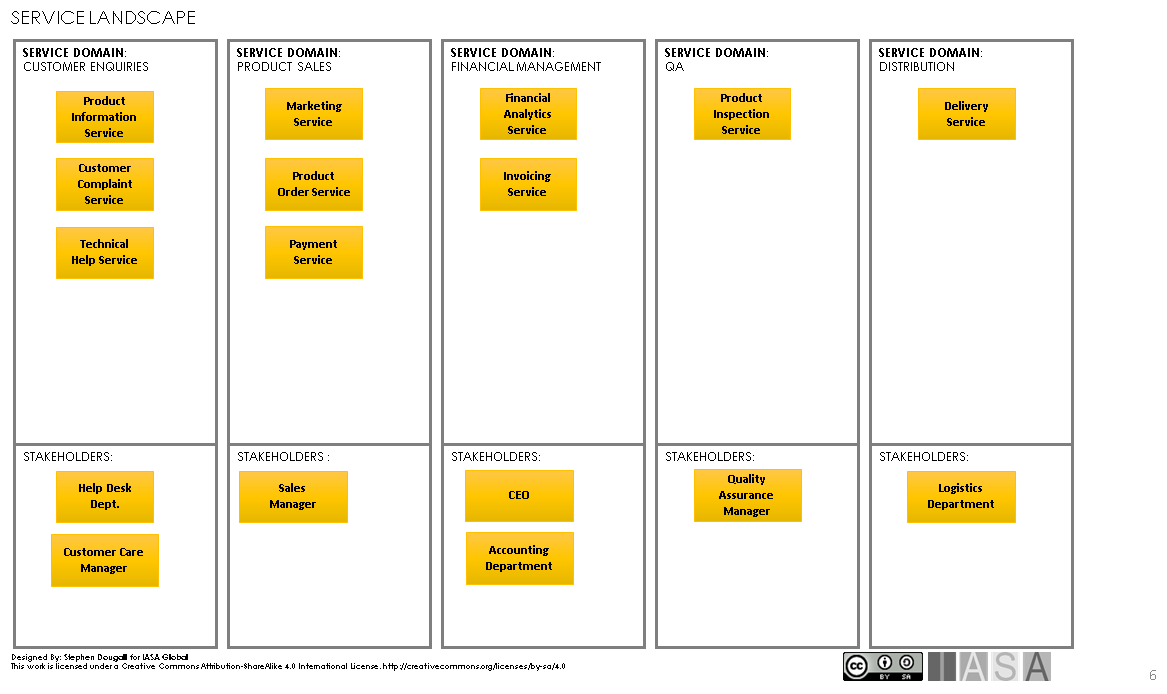
The canvas above shows a simple way to create a service landscape using service domains and stakeholders. This can be performed by individual architects or in a team using a whiteboard and sticky notes. There are two approaches to creating the service landscape:
- Service first – firstly list all the services on the canvas, then organize the services into logical groupings, these form the service domains
- Service Domain first – set the structure for the service domains, then decide which services belong in the services domains
After placing the services in the service domain it is important to define who are the stakeholders for the service domain. These stakeholders are often decision makers who play an active part in managing the strategy for services and their lifecycle. Without the stakeholders it will be unclear who is responsible for the service domain.
Using the service domain, stakeholders can take decisions to control the scope and context of the service. Some services may only be used internally within the domain and some services may be exposed outside the domain. Exposing services to other service domains, or business capabilities provides an advantage in re-use but also requires another level of control as the service will have wider scope. With services which are internal to the service domain, managing change is perhaps easier as the scope of use is reduced to the domain. Delivering services outside the service domain creates dependencies to other domains, capabilities or external consumers, which requires more effort in maintenance and operation of the services.
To help the stakeholders manage a service domain the following Service Domain Canvas can be used. This canvas can be used to describe the current strategy for services in the service domain providing the basis for a target architecture.
When working with the Service Domain Canvas it is recommended that a workshop method is used and that the stakeholders for the service domain are participants. The canvas can be placed on a whiteboard and sticky notes can be used to attach information to the canvas. The following method can be used perform the workshop:
Step 1: Confirm the Service Domain
To start the workshop make a short statement describing the Service Domain and ensure that all participants in the workshop are agreed upon the scope and context of the Service Domain.
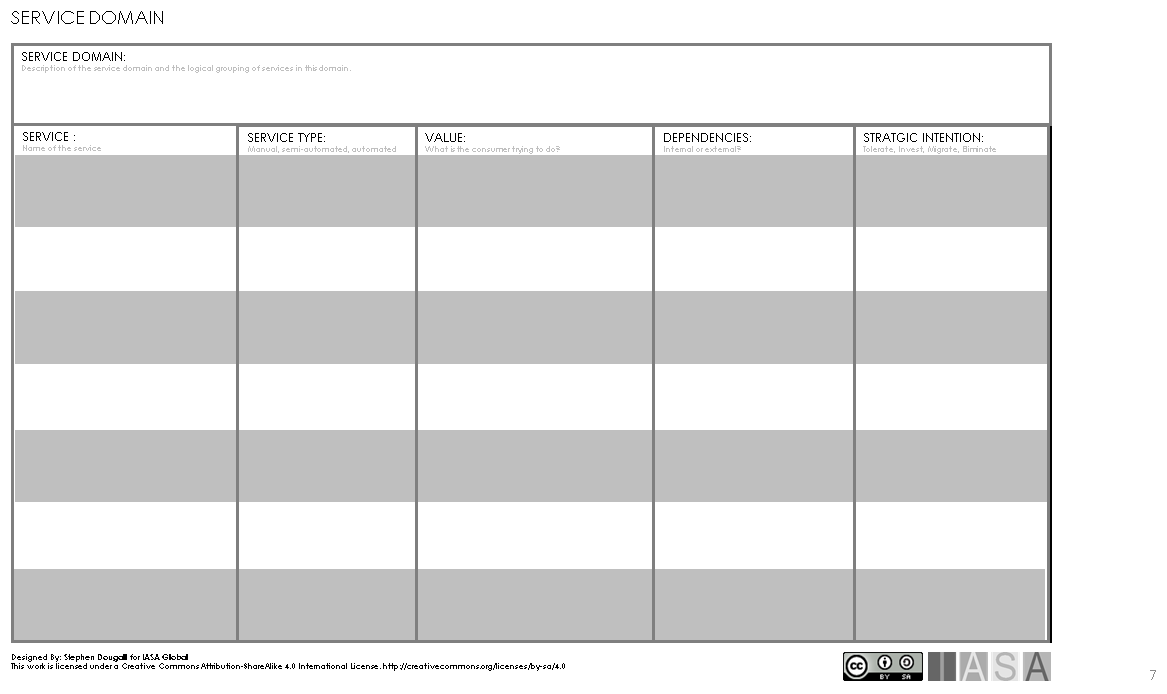
Step 2: List the services
Participants list the existing services in the domain and required services on sticky notes and place each service on a row in the canvas. When listing the services, indicate whether the service is an existing service or a new service.
Step 3: Analyze services
For each service the participants list the following attributes on sticky notes:
- Service Type – indicates whether the service is manual (human), semi-automated or fully automated.
- Value – a statement of the value which is provided by the service
- Dependencies – indicates if the service is internal to the service domain, or if it has dependencies to other service domains or external consumers
- Strategic Intention – indicates the intention of the stakeholders in maintaining the service using the TIME method (tolerate, invest, migrate or eliminate)
The notes are then placed in the correct column on the canvas and the participants discuss the attributes until agreement is reached.
Step 3 should be repeated for all services on the canvas.
Once the canvas is complete the participants will have a proposal for managing services within the service domain. The service type gives an indication of the type of resources needed in order to deliver the service, technical, human or both. It should be clear from the strategic intention which services receive investment and which services are marked for retirement. This is motivated by the value provided by the service, high value services should receive more investment. The dependencies give an indication of the effort that will be required to achieve the strategic intention, for example, a service with many dependents may require significant effort to eliminate or migrate the service.
References and further reading
SOA Principals of Service Design – Tomas Erl
Service Oriented Architecture Standards – The Open Group
Gartner’s TIME model
https://www.gartner.com/en/documents/3905663/use-time-to-engage-the-business-for-application-and-prod
What is Service-Oriented Architecture
https://www.infoworld.com/article/2071889/what-is-service-oriented-architecture.html
Service-Oriented Architecture
https://www.geeksforgeeks.org/service-oriented-architecture/

BTABoK 3.0 by IASA is licensed under a Creative Commons Attribution-NonCommercial 4.0 International License. Based on a work at https://btabok.iasaglobal.org/

